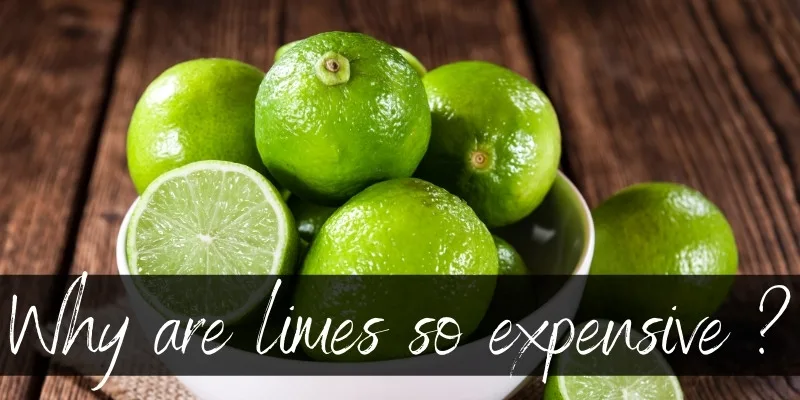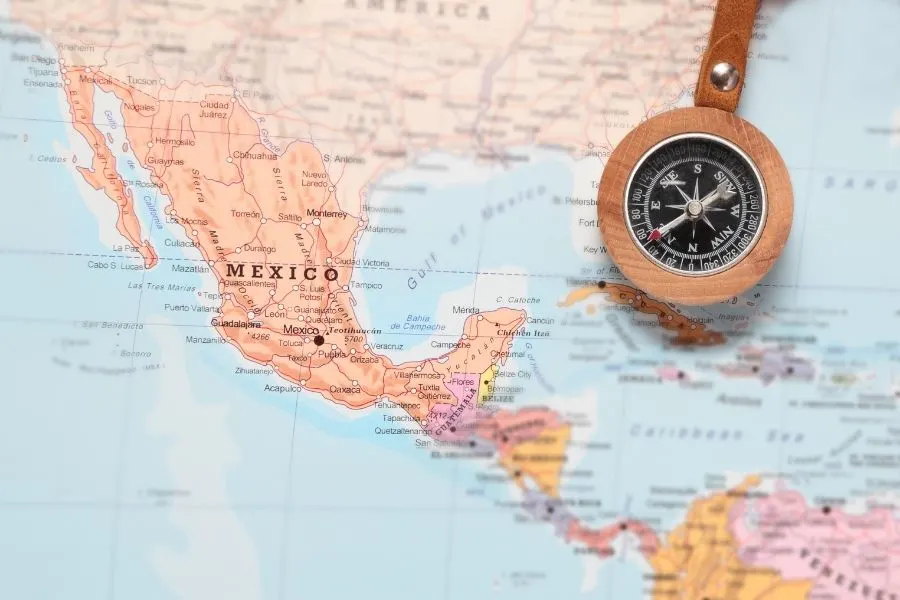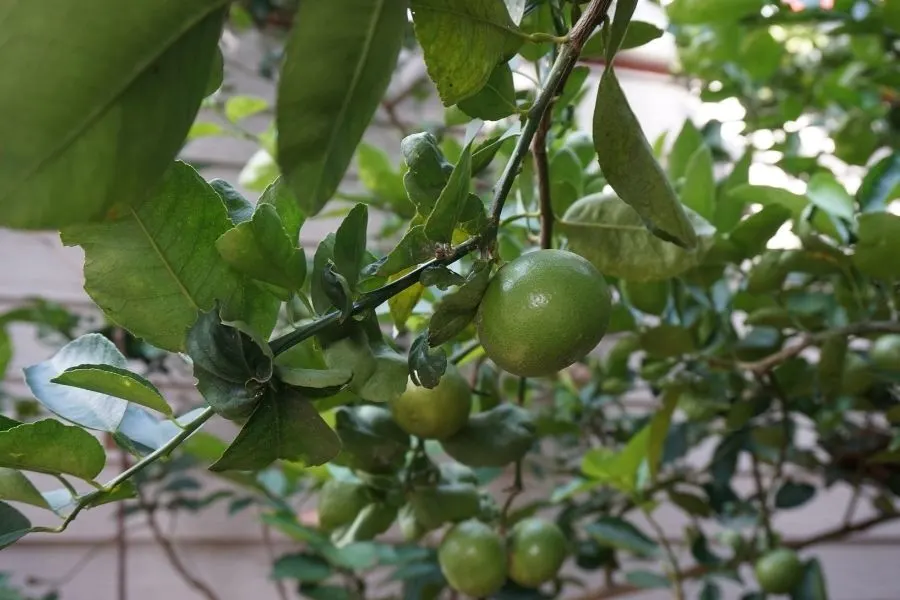Limes are exotic citrus fruits with ancient roots first discovered in Southeast Asia. While Arabian traders began transporting these small sour gems to eastern Mediterranean countries around 1000 C.E., their popularity has skyrocketed in the time since.
They are a staple in modern cuisine, such as tacos, ceviches, key lime pie, drinks and more. However, as of recent, the price of limes seems to only be getting higher.
People have started noticing and asking around, but answers seem a little hard to come by. So we’ve made it a point to find out why limes are so expensive in general, and why they’re more expensive lately. Read on to find out.

Why are limes so expensive?
Limes are expensive because they are very affected by bad weather, and prone to citrus disease, and lime shipments (like avocado) are often hijacked by drug cartels in Mexico.
Lately there’s been a long drought season in Mexico, and the lime crop has suffered. Mexico supplies nearly all of America’s limes, because they have the better climate for it.
In New Zealand for example limes are only in season from March to September, after which limes are imported from America and/or Mexico. New Zealand and Australia do grow their own limes, and have an intense import-export relation with Southeast Asia.
Even so, the total amount is always exceeded by the production in Mexico, so any major crop loss there will be felt all over the world.
Back in 2019 the price for a 40 lb case of limes was $52-55. This is the retail price, not the one you will find in stores. Due to middlemen, shipping costs, and price markup by supermarkets, you can easily find yourself paying $2 per lime.
Read Also:Why Is Rhubarb So Expensive ?
The lime situation in Mexico
The reason for this is due to a variety of factors. 98% of the limes consumed in the United States are grown in Mexico. This means whenever production and supply is halted, the consequences are significant, increasing the cost of import. If the farmer does not yield as much as anticipated due to weather and crop disease, the price goes up. Compared to their tart counterparts, lemons, limes are twice as expensive.

There is a shortage of lime production, particularly in Mexico. The current drought conditions are the main reason why production has slowed down. Not only is the quantity of limes threatened, the quality is as well.
Without proper sun exposure, water, nutrients from the soil and good air quality, fruit trees such as limes begin to die out. The limes that have been harvested are light green or yellow in color. This is unusual for a fully developed lime.
The limes often have brown spots straight off the tree, and the size of limes during difficult times can be unusually small. This indicates unripe and malnourished trees.
An important nugget of information: due to a treaty signed in 1944, Mexico has to deliver water to the Southern states of America. The problem is that Mexico is faced with drought each year and it’s become increasingly difficult to manage. The amount of water currently in Mexico’s dams is not enough for its own farms, let along exporting it.
In 2020 there have been riots and protests for months over the water shortage, and this has affected every crop, not just limes. The issue is and old and heavily disputed one, so there probably won’t be an end to it anytime soon.
What does this mean for limes ? They will probably keep being expensive, or become even more so. It’s our personal opinion that the lemon industry will probably end up covering the lime shortage. Even now you can see taco stands serving lemon wedges instead of limes, as they’re just cheaper.
What about Key lime ?
Florida limes aren’t that many. At least not enough to really satisfy domestic demands. There’s no reason to expect a successful surge in Key lime production, since the problems are the same: bad weather means bad limes. All of southern USA, Mexico, and the northern parts of South America are experiencing severe droughts each year, with hurricanes not allowing enough recovery.
So what can we do for now ? Aside from reaching for lemons, you can try looking for the cheaper limes in your neighborhood.
How to find cheaper limes
The price of limes has not only impacted consumers but also restaurants. Restaurant owners in recent years have swapped limes for lemons due to the price difference. So the question remains, “How does one find cheaper limes?” The answer may not be as difficult as you think.
You won’t have to travel south of the border to find the best deal. Shopping at your local farmers market can significantly reduce the price compared to grocery stores.
Purchasing wholesale in bulk will also lower the price compared to purchasing individually. The limes should also be in season which will aid in lowering the cost.
Lastly, produce department managers may offer ripe fruit at a discount as the shelf life is decreasing. It is possible to score a markdown deal on limes (or any other fruit for that matter), if you’re willing to use them right away.
How to store limes for longevity
Once you find an amazing deal on limes, you’ll need to know how to store them. Luckily, limes have a long shelf life compared to other citrus. You can leave your limes in the refrigerator for one month. Simply place them in the crisper drawer.
However, if you would like your limes to store even longer, you can seal them in a Ziploc bag, vacuuming the air out. They will store for 6 full months.
This is a great option if you bought in bulk and need to store your extra supply. Storing the limes at 32-42 F or 0-5 C is ideal. Ensuring your limes are juicy and do not dry out is important. These storage methods are guaranteed to increase longevity.
If you want to freeze lime, you’d definitely get more juice out of it. Freezing and thawing breaks down cell walls, which helps when squeezing fruit. However we can’t vouch for the flavor of frozen and thawed limes, or even if they retain all of their acidity.
How to grow your own limes
What if you live in a climate great for lime growing? If you live in a temperate climate, growing limes yourself is an option. Not only will they be cheaper, they will also be more tasty and nutritious as you can give each tree individual care as opposed to mass growing on a farm.

The best environment for limes is one with periodic rain, rich soil and plenty of sunlight. Temperatures should not fall below 50 F or 10 C. The germination process for limes occurs within a few weeks and seedlings will continue to grow strong. Once the seedlings have matured enough, they can be easily transported into individual pots.
As mentioned previously, lime trees are sensitive to cold and should have adequate winter protection. Interestingly enough, the seeds from grocery store limes are usually hybrids. If these seeds are used for planting, the result will be non identical limes.
On the other hand, authentic seeds will always grow identical limes. The best option is to purchase these seeds from a plant nursery that specifically deals in citrus trees.
While growing a lime tree will ensure access to the best limes, it is a long-term investment. It takes between four and ten years for lime trees to fruit.
Read Also:Why Are Cherries So Expensive ?
Maximize your limes, get creative
There are several ways to get the most out of your limes aside from proper storage. While storing them at the right temperature and moisture level is important, there are other options to save these valuable citrus fruits.
First, you can freeze limes. It is best to freeze individually and then store together in a bag. Do not cut the fruit prior to freezing as this will reduce their freshness. When the peel is kept on longer, they retain more of their nutrients, flavor and juice.
Secondly, you can juice fresh limes with a citrus juicer and store in an airtight container. This is especially important when making dishes that call for the juice of a lime. By making the juice when the fruit is fresh, you are able to maximize the flavor and lock it in.
An airtight container will prevent the juice from spoiling. To extend the shelf life of the juice even more, you can pour it into freezer cubes and pop out whenever needed! It’s as simple as that!
Lastly, everyone loves a tart lime zest. Lime zest should only be done with fresh limes as the flavor palette is enhanced. However, if you do not have access to fresh lime zest, you can zest and freeze.
Simply zest the lime and store in the freezer to sprinkle onto your next meal. While fresh is ideal, this is a better option than using lime powder. Regardless of which method you use to enjoy your limes, one things for sure: limes have a tangy legacy from ancient trade in Asia to modern day cuisine in Mexico.
Conclusion
Limes are expensive because most of them come from Mexico, and since we can see that there are many difficulties in meeting the demand, the clear consequence is a lime price hike.
This is not true for the lemons since they are imported from different places around the world, making them much cheaper than limes. And to be honest, they are a great substitute. Limes work better in a few recipes and cocktails, but sometimes the price is way too high not to swap them with lemons.

